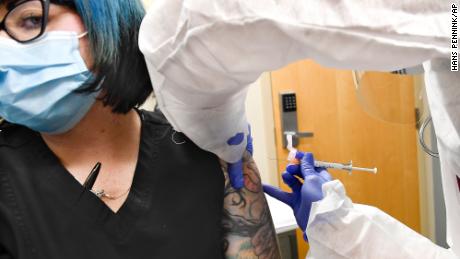Early in the outbreak, health experts stressed that older adults were most at risk for the virus that has infected more than 4.8 million people in the United States, but new data from the World Health Organization shows that most cases — by far — are reported in people ages 25 to 64. The proportion of cases in teens and young adults has gone up six-fold, and in very young children and babies the proportion has increased seven-fold, WHO said.
The increase might be explained by broader testing, greater detection of milder cases and shifting demographics of hotspots, but “a rise in risky behavior after easing of public health and social measures” is also to blame, WHO said.
“This is a disease everyone should take seriously. Please watch out for each other,” Dr. Lawton Davis, the Health Director for Georgia’s Coastal Health District, said.
A resurgence of large parties and social outings have been a source of widespread infections following the loosening of restrictions, and they are most often attended by younger people, Los Angeles County Department of Public Health Director Dr. Barbara Ferrer said Wednesday. They have recently become the hardest hit population in the county and continue to drive numbers up, she said.
In New Mexico, where one fifth of all cases are reported in people ages 20 to 29, the state’s Human Services secretary, Dr. David Scrase, urged people not to plan big gatherings for Labor Day.
“Just do that cookout with the people you live with,” Scrase said Thursday. “Don’t get the family together. There will be more time to do that.”
Masks could save 70,000 lives
More than 160,000 have died of coronavirus in the US so far and that number could nearly double by December, the director of a leading model said Thursday.
But consistently wearing masks could save nearly 70,000 of the 295,000 people projected to die of the virus by December 1, the University of Washington’s Institute for Health Metrics and Evaluation (IHME) director Dr. Christopher Murray said on CNN’s Global Town Hall.
“It’s rare that you see something so simple, so inexpensive, so easy for everybody to participate in can have such an extraordinary impact in the US and also all over the world,” Murray said.
At least 39 states as well as Washington, DC and Puerto Rico have implemented mask requirements of some kind. Kentucky Gov. Andy Beshear extended his state’s mask mandate by 30 days on Thursday, saying “It’s working.”
The US Centers for Disease Control and Prevention updated mask recommendations on its website, urging people not use masks with valves or vents. While the one-way valve keeps people cooler by allowing air to escape, that also means respiratory droplets that carry the virus can escape and infect others.
Balancing rush for a vaccine and ‘ethical principles’
Vaccines are being developing quickly in hopes of getting the pandemic under control, but health experts caution they will only be released to the public once they are safe.
Dr. Anthony Fauci, director of the National Institute of Allergy and Infectious Diseases, said he is looking forward to getting the vaccine when it has reached a necessary standard.
“When the vaccine becomes available after a 30,000-person-or-more placebo-controlled randomized trial, and it’s shown to be safe and effective, I would get it any time within the timeframe of the people who prioritize it according to ethical principles,” Fauci told the POLITICO Pulse Check podcast.
He said he is “satisfied” with the first week enrollment in Moderna’s Phase 3 clinical trial for a coronavirus vaccine, which saw 1,290 people randomly assigned to get either the vaccine or a dummy shot. Moderna plans to enroll 30,000 people in its trial.
Fauci told CNN that he expects “to get an answer” about whether the vaccine works in November or December.
President Donald Trump hopes to get an answer much sooner. He said Thursday he is “optimistic” that a vaccine could be ready by election day on November 3.
But former Surgeon General Dr. Vivek Murthy told CNN’s Wolf Blitzer Thursday that giving specific dates for when a vaccine could be available is “very dangerous.”
“We can’t sacrifice our standards because if we do, it not only hurts people, but it’s going to damage people’s faith in vaccine efforts,” Murthy said.
Experts call for a national plan
Federal officials have often been at odds with local leaders and health experts, and five former directors of the CDC said it is time for national leadership against the pandemic.
“It’s unbelievable that six months into the pandemic, it’s not clear who’s in charge, federally,” Dr. Thomas Frieden said during a roundtable hosted by ABC News Live. “There’s no plan. There’s no common data that we’re looking at to see what’s happening with the virus and what’s happening with our response.”
The CDC being sidelined early on and contradictory messages from the Trump administration has led to partisanship, confusion and increased spread of the virus, Frieden said.
Dr. Richard Besser, who was an acting CDC chief during the H1N1 swine flu pandemic in 2009, said return to school has been complicated by the mixed messages. “If you have politicians saying that CDC guidance is a barrier to getting children back into school, instead of the roadmap for doing it safely, then whole system breaks down,” Besser said.
In the absence of national leadership, state officials have been taking measures against the virus into their own hands.
Louisiana Gov. John Bel Edwards extended bar closures Thursday and announced the state will stay in Phase Two of its reopening plan, and New York City Mayor Bill de Blasio extended the city’s state of emergency, which was first signed in March, for another 30 days.
CNN’s Lauren Mascarenhas, Shelby Lin Erdman, Maggie Fox, Jamiel Lynch, Elizabeth Cohen, Hollie Silverman, Jen Christensen and Elizabeth Hartfield contributed to this report.





